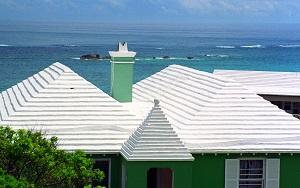Here’s a question you’ve (likely) never asked anyone before: Where does Bermuda get its drinking water from?
A rudimentary question, at best. However, a closer investigation into the topic, a legacy is revealed. A legacy of water engineering and management that the world could learn from.
Bermuda is essentially a series of small islands that are joined via bridges to make up a large land mass. The islands were built upon porous limestone mountain ranges produced by a now-extinct volcano.
Being so far out in the North Atlantic Ocean there is simply no fresh water in Bermuda. Even the lakes and water wells are brackish. Therein lies a clue: they are surrounded by the abundant ocean. Removing salt from salt water using desalination plants is perhaps the answer today, but how did the human beings who settled in Bermuda 400 years ago access drinking water? They needed a practical solution.
The short answer to the question is rainwater and roofing.
Bermuda’s roofs are engineered in such a way that they harvest rainwater. By law, every Bermudan house and building must employ the same style. Rain water was, and still is, the only source of truly fresh drinking water.
These roofs are civil engineering masterpieces, dating back to 1609.
How do they work?
The original settlers took the super absorbent, porous limestone Bermuda was built on, crafted it into roof tiles, and used these to construct stepped roofs. The roofs capture, and slow down, any rain droplets that hit them. This harvested rainwater is then collected into gutters which then transfer the water into storage tanks under the houses.
Traditionally the roofs were painted with what was known as a ‘lime-wash’, after construction was completed. The lime-wash had antibacterial properties. Currently, however, the roofs are still painted white because this reflects ultra-violet light from the sun, which also helps to purify the water.
Bermudans capture an average of 350,000 liters of water per house, per year. This is a startling achievement, but still Bermuda could not depend on this water catchment alone.
In response six desalination plants have been constructed; they produce 13,500 cubic meters of water per day so help address other water requirements that the island has.
Vital water infrastructure
Bermudan scientist, Tarik Smith, knows – all too well – how important water management is. He is now sharing this expertise with international research and development.
He delivered a speech at the Division of Arts and Science Corange’s public forum, named: “Water Engineering: Facing the Challenges of Water Management”.
In an interview with the Royal Gazette, he stressed the importance of research into water management and mentioned the benefits of recycling water – already used in may countries around the world. He also revealed a justified pride in the rainwater harvesting system in Bermuda. He said:
“Bermuda is very conscious in terms of water consumption. Rainwater harvesting systems are a model for many countries. I think we don’t realise how advanced we are with respect to that. Many places have a lot to learn from Bermuda,”
Are desalination plants the future?
In a book, published in 2015, named Concentrating Solar Power and Desalination Plants: Engineering and Economics of Coupling Multi-Effect Distillation and Solar Plants, it is revealed that water scarcity will only intensify. The authors detail that by 2030 47% of the world’s population “will be living in areas of high water stress.” The other 67% will not have adequate sanitation.
Desalination plants are becoming one of the only solutions to those grim statistics. Taking salt out of the seawater through reverse osmosis is the most used method around the world.
Countries in the Middle East are already utilizing desalination plants on a mass-scale due to their scarcity of water. In fact 70% of the world’s desalination plants are housed in the Middle East.
Credit: BetterWorldSolutions.eu / Desalination plant, Ras Alkhair, Saudi Arabia,
To see how a desalination plant works watch this video from Veolia Middle East. This company operates the Sur Desalination Plant in the Sharqiyah region:
There are unfortunately drawbacks with the use of desalination plants. Fossil fuels power their operations and this of course produces pollution. Moreover, the water from the plants has been called into question due to its lack of magnesium and other minerals normally found in fresh water.
Another concern is the waste. Concentrated salt is pumped back into the ocean, but is also mixed with the chemicals that facilitated the initial desalination process.
Despite the negatives and with engineers dedicated to the problem, these novel approaches to water management can only improve and they bode well for a future of depleting water resources.
Works Cited
Low, Harry. “Why Houses in Bermuda Have White Stepped Roofs.” BBC News. BBC, 23 Dec. 2016. Web. 07 Feb. 2017.
PBSNewsHour. “Is Desalination the Future of Drought Relief in California?” YouTube. YouTube, 31 Oct. 2015. Web. 07 Feb. 2017.
“Water Management: A Worldwide Challenge | The Royal Gazette:Bermuda News.” The Royal Gazette. 25 Jan. 2017. Web. 07 Feb. 2017.
Bermudabea. “Bermuda’s Water Catchment.” YouTube. YouTube, 06 July 2010. Web. 07 Feb. 2017.




